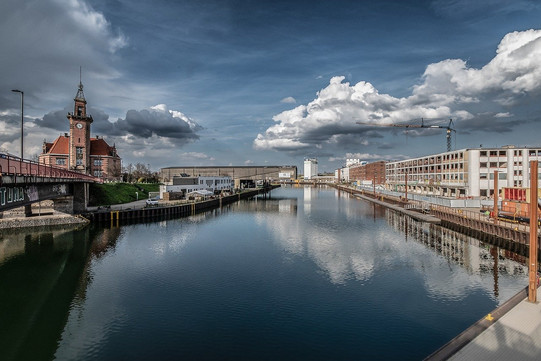
A 02 - Urban transformation at Dortmund's port - planning as a "wicked problem"
Mathematical problems are not always easy to solve, but the task, e.g. in the form of an equation, is completely unambiguous and there is a clear correct solution and clearly incorrect results. According to Rittel and Webber (1992), planning problems are different or even "wicked" (usually translated as "malicious" or "tricky"). In contrast to the mathematical equation, the description of a complex spatial problem cannot be right or wrong according to the authors, but is dependent on perspectives and normative evaluations; the same applies to the countless possible solutions to such a problem. Further characteristics of "wicked problems" are that objectives and measures for solving problems (also elsewhere) give rise to new problems. The "trial and error" principle is also not applicable to problem-solving measures here, as, for example, built development cannot simply and quickly be converted back into a park.
Against this background, the project will focus on the planning and development of Dortmund's port, in particular the Speicherstrasse district development. Since 2009, the city of Dortmund has been driving forward the transformation of this area from an industrial port to a "scene district" (WAZ 2010), "digital hotspot" (Wirtschaftsförderung Dortmund 2024) and "district for all" (ibid.). As a result, the district has already undergone extensive (structural) changes. However, the plans are not yet complete: A relocation of the Dortmund University of Applied Sciences to the quarter is currently being discussed. As part of a case study analysis, we will take a closer look at the institutions and actors involved and the different types of knowledge that flow into problem definitions, decision-making and planning processes and ultimately the development of the area. What exactly is the problem here? What is to be developed there, why and for whom? What are the opinions, wishes and positions of the stakeholders and what will become of them? The extent to which the development of the Port of Dortmund represents a "malicious planning problem" can serve as a guiding overarching research question and be further differentiated in the course of the project.
The research methods used could include
- Site visit(s)
- Mapping(s)
- Actor analysis(s)
- Survey(s)
- Interview methods (experts, problem-centered, informal conversations, walk-along etc.)
- Visual analyses (image, photo, video analyses of e.g. image films and designs)







![[Translate to English:] [Translate to English:]](/storages/epc-raumplanung/_processed_/8/e/csm_Rotterdam_gelbeBruecke_KarZim_f6ebd59e22.jpg)
![[Translate to English:] [Translate to English:]](/storages/epc-raumplanung/_processed_/3/5/csm_Rotterdam_KarZim_73a906454b.jpg)
![[Translate to English:] [Translate to English:]](/storages/epc-raumplanung/_processed_/a/8/csm_2SaoPaulo_KarZimm_cd6c9dff0d.jpeg)
![[Translate to English:] [Translate to English:]](/storages/epc-raumplanung/_processed_/8/e/csm_Rotterdam_gelbeBruecke_KarZim_cda2fb0b89.jpg)